The herbaceous annual or perennial plant Leucanthemum is a member of the Asteraceae or Asteraceae family. Previously, this plant was attributed to the genus Chrysanthemum. Nivyanik differs from chrysanthemum in that it does not have a characteristic smell for this genus, and it also does not have pubescence, consisting of light gray pile. According to various information, this genus includes 20–70 different species. The scientific name of this genus "leucanthemum" in translation from Greek means "white flower", the Russian name for this flower "nivyanik" comes from the word "niva". Most types of daisy are found in Asia and Europe in regions with a temperate climate. This plant can also be found in New Zealand, North America and Australia. Gardeners often refer to this plant as garden chamomile. It is very popular in landscaping as well as landscaping.
Content
Nivyanik features
The flowering herbaceous plant has a red rhizome. The leafy straight shoots are small-branched, their height varies from 0.3 to 1.2 m. Whole lobed or crenate leaf plates along the edge have a lanceolate-oblong shape and a dark green color. The leaf plates are either basal or stem, and this depends on the type of cornflower. Large flowers reach 60-120 mm in diameter, and outwardly they are very similar to chamomile. The flowers are inflorescences-baskets, which include tubular yellow flowers that surround the marginal ligulate flowers of yellow or white. Inflorescences are located at the ends of the shoots. The daisy blooms twice a season, or rather: in May – July and August – September. In the center of the basket, seeds ripen, which remain viable for 2 to 3 years.
Growing a lemongrass from seeds
There is one advantage to growing a lemongrass through seedlings, the fact that such plants will begin to bloom already in the current season. Sowing seeds for seedlings is carried out in the last days of February or the first - in March. For crops, you can take absolutely any containers (boxes, cups, bowls, etc.), because in the future, the seedlings will need to be cut out. However, to make it easier to keep soil moisture under control, it is better to take a shallow container for crops.The containers are filled with ready-made soil mixture intended for planting flower seedlings, but if you wish, you can take a mixture consisting of sand and high peat. Before sowing, the soil mixture and the container must be disinfected using a solution of potassium manganese. To begin with, a good drainage layer should be made at the bottom of the container, which is covered with soil mixture. The container must be filled not to the top, 20–30 mm below the edge. The surface of the substrate should be leveled, after which it is necessary to evenly distribute the seeds, which are deepened by only 10 mm and sprinkled with a thin layer of soil mixture. Crops should be moistened with a fine spray.
You do not need to cover the container, but it is moved to a warm place (about 22 degrees). After the first seedlings appear, the container must be rearranged to a cooler place (from 18 to 20 degrees). When the plants are 4 weeks old, they should be fertilized with a weak mullein solution. The picking of seedlings is carried out at the age of one and a half months, for this they are seated in individual cups, which should be filled with soil mixture of the same composition, but a little humus should be poured into it. When choosing cups, it should be borne in mind that seedlings will grow in them before transplanting into open soil. When several days have passed after the transplant, the plants will need 1 more feeding, for which they use an organic solution. It should be noted that the interval between these two dressings should be approximately 20-30 days. Seedlings are planted in open soil in May, but only when the threat of spring frosts has passed. However, before planting, the plant should be hardened for 15 days.
In diameter, the planting holes should reach 0.3 m, the distance between them directly depends on the variety of the cornflower and varies from 0.3 to 0.7 m. The distance between the rows should be at least 20 centimeters. Before planting on the bottom of the hole, you must put 20 grams of complete mineral fertilizer, as well as from 300 to 400 grams of compost or humus. Seedlings are planted together with a clod of earth, and the holes are covered with nutritious soil. The planted plants need abundant watering. After the liquid is completely absorbed into the soil, and its surface dries out a little, the site is covered with a layer of mulch, which is used as a mixture of saltpeter and sawdust (20 grams of nitrate per 1 bucket of sawdust).
Planting the daisy in open ground
If you sow seeds directly into open soil, then during the first year, the plants will observe the formation of a leaf rosette and a root system. The first flowering can be seen only in the second year of growth. Sowing seeds in open ground is carried out in early spring or in autumn.
In the same place without transplanting, this plant can be grown for seven years, in this regard, the choice of a site for planting should be especially careful. The site should be sunny with moderately moist, well-drained soil, while it should be cultivated to a depth of 0.25 to 0.3 m. Chernozem is best suited for growing a daisy. If the soil is dry or poor, then the size of the inflorescences in the bushes growing on it will be small compared to those grown on fertile soil. When grown in shade, the bushes are characterized by a slower development, while their flowering is less lush and effective. It is necessary to add humus to excessively heavy or light soil (20 and 15 kilograms are taken per 1 square meter, respectively). This culture should not be planted in light sandy or heavy clay soil, and excessively damp places are not suitable for this, since there is a high probability that the daisy will develop a fungal disease and grow old rapidly.
Dig up the soil and level its surface. Then you need to make grooves, while the distance between them should be at least 20 centimeters.You need to deepen the seeds into the soil by 20 mm. After that, they are sealed, and the site is watered abundantly. On the next day, the surface of the site should be covered with a layer of mulch (peat). After the seedlings appear, it is necessary to thin them out.
If the sowing was under winter, then the first seedlings should appear already at the beginning of the spring period, if in May the plants are transplanted to a permanent place, then there is a high probability that the bushes will bloom in the fall. If the seeds were sown in the spring, then in the fall you will have a strong and fully formed seedling. It must be transplanted to a permanent place (the planting scheme is described above), after the plants take root, they will need to be covered for the winter.
Caring for the sycamore in the garden
There is nothing difficult in caring for a nivyan. Bushes should be provided with timely watering, top dressing, weeding, loosening of the soil surface. In order for the bushes to always look spectacular and beautiful, you need to cut off the baskets that have begun to fade in time. Watering is carried out only during a drought, while 1 bucket of water should be consumed per 1 square meter of the plot. After the rain has passed or watering is carried out, the soil surface between the bushes will need to be loosened, while pulling out all the weeds.
It is recommended to use Nitrofoska for feeding the daisy: at the beginning of the growing season, a solution should be used in which the nitrogen content is high, and during budding it should be dominated by potassium. It is also recommended to feed this culture with mullein solution. If there is such an opportunity, then such organic matter should be introduced into the soil 1 time in half a month and then there will be no need to feed the daisy with mineral fertilizers. However, in this case, during the budding period, bone meal must be added to the soil instead of Nitrofoska. When flowering is over, the bushes will begin to lose their decorative effect extremely quickly, in which case their stems must be shortened to 10-15 centimeters.
Diseases and pests
In rainy weather, the bushes can infect fungal diseases, especially if it rains for a long time. Eurasian grass can suffer from rust, powdery mildew, downy mildew, spotting, fusarium, stem rot, and bacterial cancer. At the first symptoms of any of the listed diseases, the bush should be well sprayed with Bordeaux mixture (1%), if there is such a need, then this procedure will need to be repeated 2 or 3 more times with an interval of one and a half weeks. However, before starting processing, those bushes that are very strongly affected are best dug up and destroyed.
Slobbering pennies, meadow thrips and chrysanthemum miners can settle on the bushes. To clean the bushes from such harmful insects, they and the surface of the soil under them should be sprayed several times with a solution of Bazudin, Inta-vira, Aplaud or Vermitik. Also, for processing, you can use an infusion of plants with insecticidal properties, such as celandine, marigolds or yarrow. Experienced gardeners recommend treating the plant immediately with insecticidal preparations, because they are much stronger than folk remedies and are more effective.
Types and varieties of nivyanik with photos and names
Gardeners cultivate several types of cornflower, as well as a very large number of its various varieties.
Marsh daisy (Leucanthemum paludosum), or marsh chrysanthemum (Chrysanthemum paludosum = Hymenostemma paludosum)
This species is native to the southern regions of Spain and Portugal. The height of the bush is no more than 0.25 m, but it is distinguished by its incredible splendor. Its leafy, branching shoots can be inclined or erect. Saturated green sessile leaf plates are alternately crenate or spatulate along the edge.Many baskets grow, which reach 30 mm in diameter, tubular yellow flowers are collected in a large disc, which is framed by short marginal ligulate flowers. Flowering begins in the last days of June and lasts until the first frost.
Kuril daisy (Leucanthemum kurilense)
This species is a Kuril-North Japanese endemic. This rocky chamomile blooms late, and it comes from the East Asian islands of Hokkaido, Kuril Islands and Honshu. This perennial plant reaches a height of only 0.2 m, and it prefers to grow on coastal sands, rocks and rubble. Fingered leaf plates are three-lobed or five-lobed, in contours - from kidney-shaped to rounded. The rhizome is thick and fleshy. Large inflorescences can be single or few, they include yellow tubular and white reed flowers.
Leucanthemum maximum
The birthplace of this species is the Pyrenees. This perennial has a ground-rooting rhizome. It has many branching shoots, the height of which can vary from 0.5 to 1 meter. Stem leaf plates are lower - petiolate and spatulate, as well as upper - oblong, sessile and crenate along the edge. The diameter of the inflorescences is about 12 centimeters, they include tubular median flowers of yellow color, as well as reed white flowers, which are arranged in 2 rows. In terry varieties, the baskets are very similar to chrysanthemums: they are filled with several rows of white reed flowers, while the corolla, consisting of tubular flowers and located in the middle, is also painted white. Flowering of this species begins somewhat later than other species, or rather, after the first decade of July. Cultivated since 1816 Popular varieties:
- Alaska... Inflorescences reach 10 centimeters across, white reed flowers are arranged in 1 row.
- Beethoven... The bushes bloom very profusely, and their height is about 50 cm. The inflorescences are simple, outwardly similar to chamomile.
- Christine Hagemann... The height of the bushes is about 0.7 m, the baskets are terry.
- Little Princesses... The height of the graceful bush is about 0.2 m, the inflorescence is large, white.
- Snow Lady... In such annuals, baskets reach 17 centimeters in diameter.
- Stern von Antwerp. The bush is tall, the baskets in diameter reach about 10 centimeters. The tubular flowers are yellow, and the reed flowers are white.
Common daisy (Leucanthemum vulgare), or meadow chamomile
This species is the most famous, and it is also called garden chamomile. In the wild, it prefers to grow in forest glades and meadows in the southern regions of Siberia and Europe. The height of such a perennial is from 0.8 to 0.9 m. The lower leaf plates are stem, whole, they have an obovate shape, and the upper ones are oblong. Single inflorescences reach 60–70 mm in diameter, they include small yellow median and 1 row of white reed flowers. It has been cultivated since 1500. In middle latitudes, the beginning of flowering of this species falls on the last days of May or the first days of June. Popular varieties:
- Maxima Koenig... The height of the bush is about 100 cm. In diameter, the inflorescence reaches 12 centimeters, it consists of tubular median flowers of a dark yellow color, as well as 1 or 2 rows of reed white flowers.
- May Queen... The bush reaches a height of half a meter. He has very showy baskets, as well as beautiful dark green shiny leaf plates.
- Sanssouci... The height of the bush is about 100 cm. Baskets reach 12 centimeters across, they consist of a small number of yellow median flowers and ligulate white flowers, reaching 50 mm in length and located in 6-8 rows.


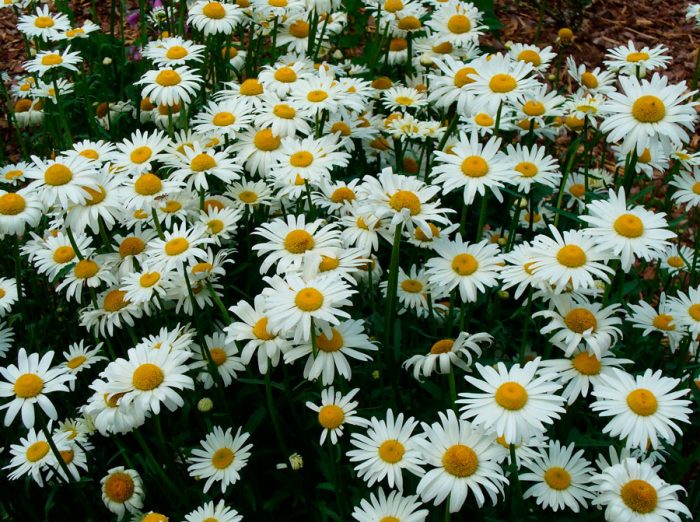
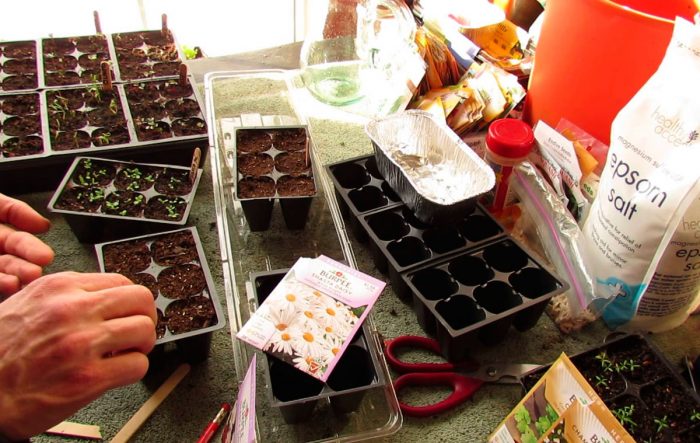
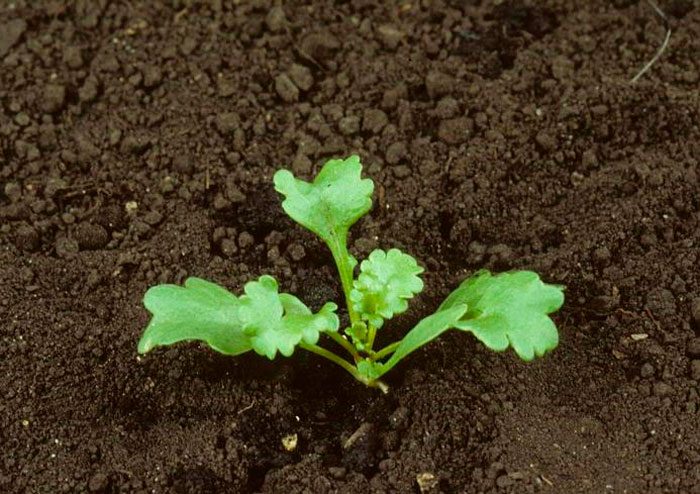
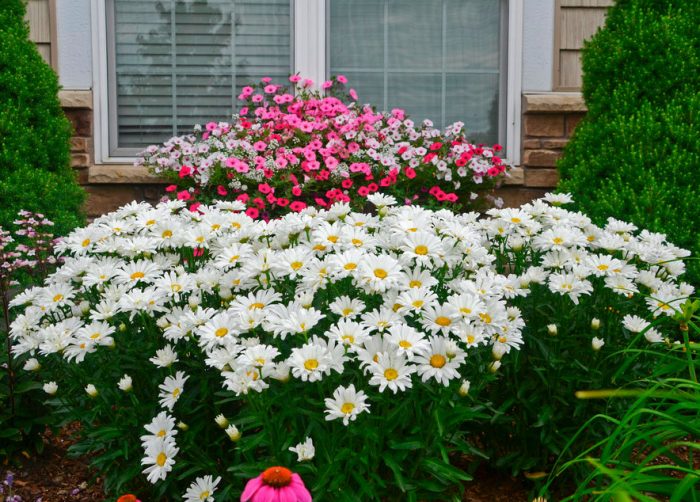
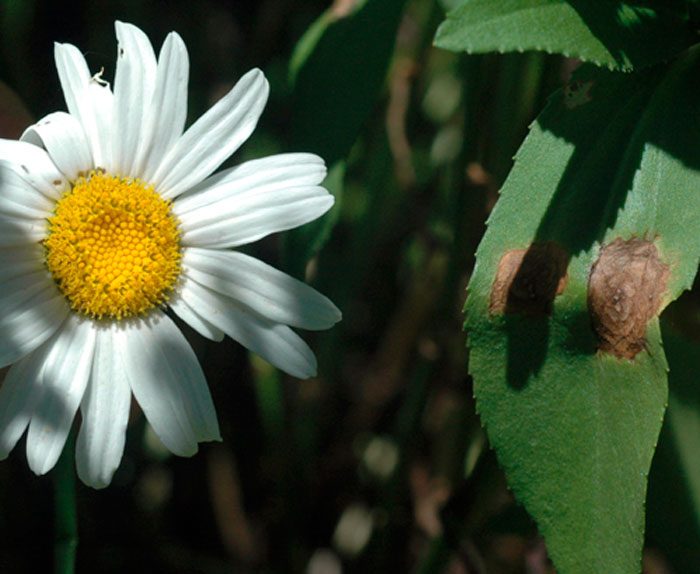
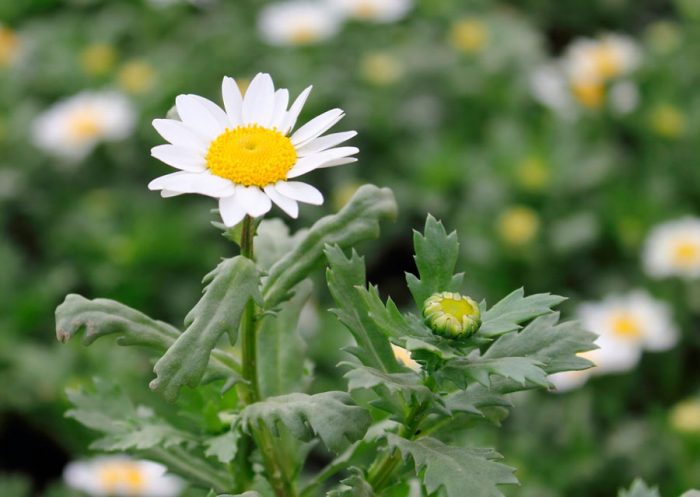
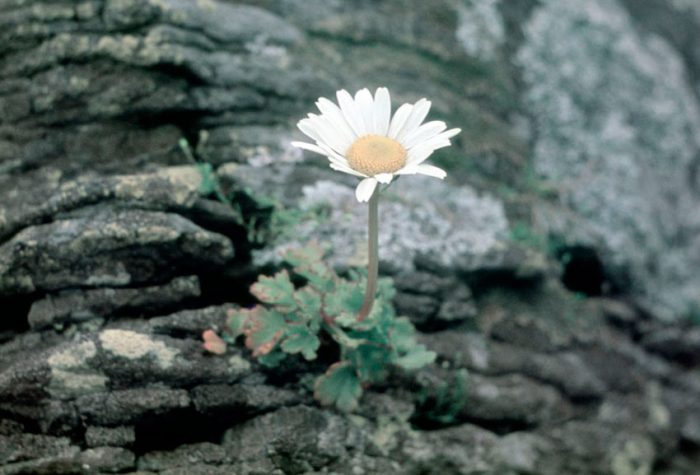
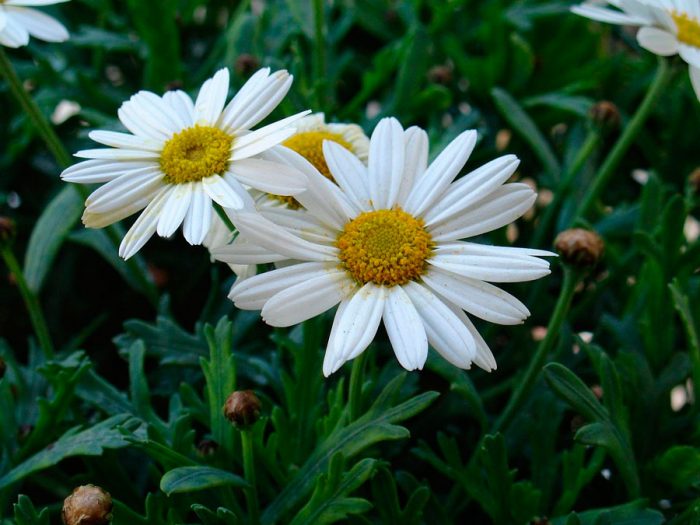
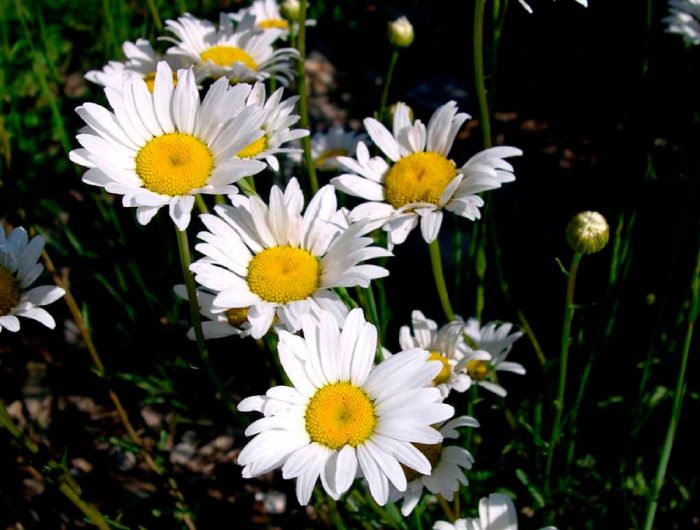



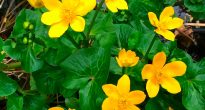






A beautiful, not capricious plant for an autumn garden.